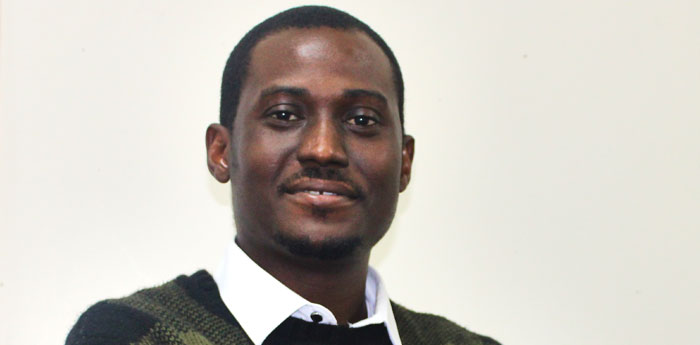Dr Adesola Ademiloye is a Senior Lecturer in the Department of Biomedical Engineering, where he serves as the coordinator for the Swansea-Texas A&M University Exchange Programme. He is a member of the Zienkiewicz Centre for Computational Engineering (ZCCE). In addition to research, Dr Ademiloye is passionate about teaching, mentoring, stewardship, and racial equality. He currently co-chairs the Swansea International Race Equality Network (SIREN).
What is your field of research?
I am a Civil Engineer by training and a Biomedical Engineer by choice. My research cuts across the fields of computational mechanics and physiology, multiscale modelling, mechanics of materials and numerical methods. More recently, I have become interested in studying the mechanics of engineering and biological materials using molecular dynamics simulation and artificial intelligence.

How did you become interested in the field?
As an undergraduate student in Civil Engineering at Ekiti State University, Nigeria, I had a very strong interest in Structural Mechanics, and I was drawn to the world of academic research through one- to-one conversations with my lecturers, especially Dr Olayiwola Oni.
Following my undergraduate degree, I applied for the Hong Kong PhD Fellowship Scheme (HKPFS) in 2012 and secured a scholarship to complete my PhD in Civil Engineering at the City University of Hong Kong (CityU) under the supervision of Professor KM Liew, a highly cited researcher in computational mechanics.
Despite my keen interest in structural mechanics, doing a PhD in computational biomechanics was incredibly challenging. My interest in the field of computational biomechanics grew over time due to the incredible mentoring and support that I received from my PhD supervisor. Secondly, I was intrigued by the fact that the same numerical techniques that I had previously used to analyse structural members in buildings could be used to model the behaviours of red blood cells and other biological materials in healthy and diseased conditions.
How did you come to work at Swansea University?
After finishing my doctorate, I worked at CityU as a Postdoctoral Research Associate for about 13 months. I then joined Swansea University in October 2018 as a Lecturer to work with world-leading researchers in computational engineering at the Zienkiewicz Centre for Computational Engineering (ZCCE). I learned about Swansea University through Professor Perumal Nithiarasu who was the co-chair of the international conference on Computational and Mathematical Biomedical Engineering (CMBE) held at CityU in December 2013. I subsequently discovered the pioneering role of Professor Olek Zienkiewicz in the development of the Finite Element Method during my PhD program. Since I joined Swansea University, I have met and worked with many other amazing colleagues. It is also a great privilege to now serve as a member of the organising committee of the CMBE conference series.
What do you hope to achieve with your research?
My research can be broadly divided into two themes – computational mechanics and computational physiology. The overarching goal of my research is to advance knowledge and innovation by providing new insights into the mechanical properties of engineering and biological materials through computational modelling across various length scales. As microscale composition and configuration of materials affect their macroscale response, my ongoing research efforts in computational physiology are aimed at revealing how microscopic changes in red blood cell membrane lead to the system-level manifestation of blood-related diseases such as malaria, type 2 diabetes, and thalassemia. In the area of computational mechanics, I aim to contribute to the development of advanced numerical methods such as meshfree and particle methods, which can be applied to tackle important problems in fire engineering, impact protection and structural energy storage by investigating the mechanical behaviours of engineering materials (such as laminated glass, graphene, and porous electrodes in lithium-ion batteries) in complex and/or extreme conditions.
What practical applications could your research have?
Generally, fundamental research requires a long-term horizon. Despite all that is known about certain diseases such as malaria, type 2 diabetes, and sickle cell anaemia, they still account for the death of many people (both adults and children) around the world.
I am hopeful that the new insights and actionable data from my research in computational physiology will help guide clinical decision-making processes and improve targeted drug delivery. In addition, my research in computational mechanics will contribute to making our society safer and greener by providing a better understanding of the failure of engineering materials and delivering optimisation guidelines to industrial partners, consequently improving their service lifespan, and reducing waste.
What is next for your research?
Currently, I am investigating the coupling of metabolism and mechanics within a multiscale modelling framework. This new computational framework can be employed to provide new insights into how metabolic changes lead to the progression of blood-related diseases such as type 2 diabetes, thus paving the way for improved point-of-care diagnosis and targeted treatment of metabolic diseases. I am also interested in using artificial intelligence and imaging to explore the pathophysiology of thalassaemia and atherosclerosis. In addition to these research directions, I am working on the mechanical behaviour and failure of structural energy storage devices with Dr Yang Zhang, my collaborator at Nanjing University of Science and Technology, China. Despite the challenges of securing research grants, I am optimistic that my research will make a massive difference.
